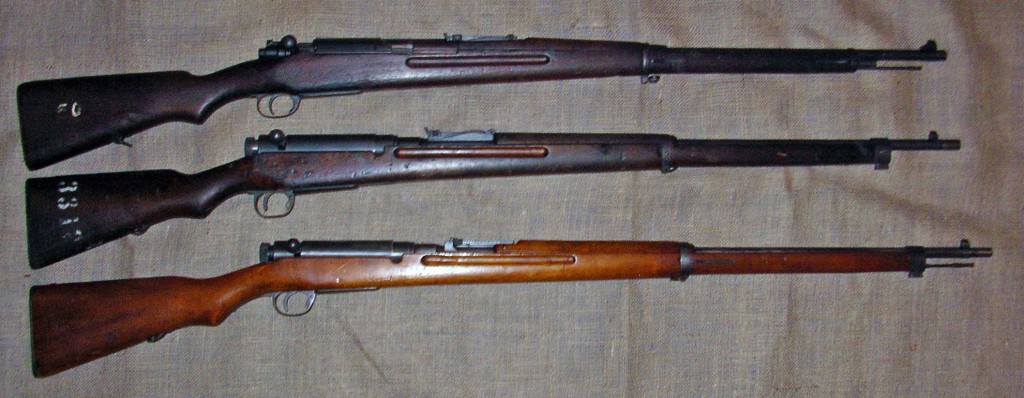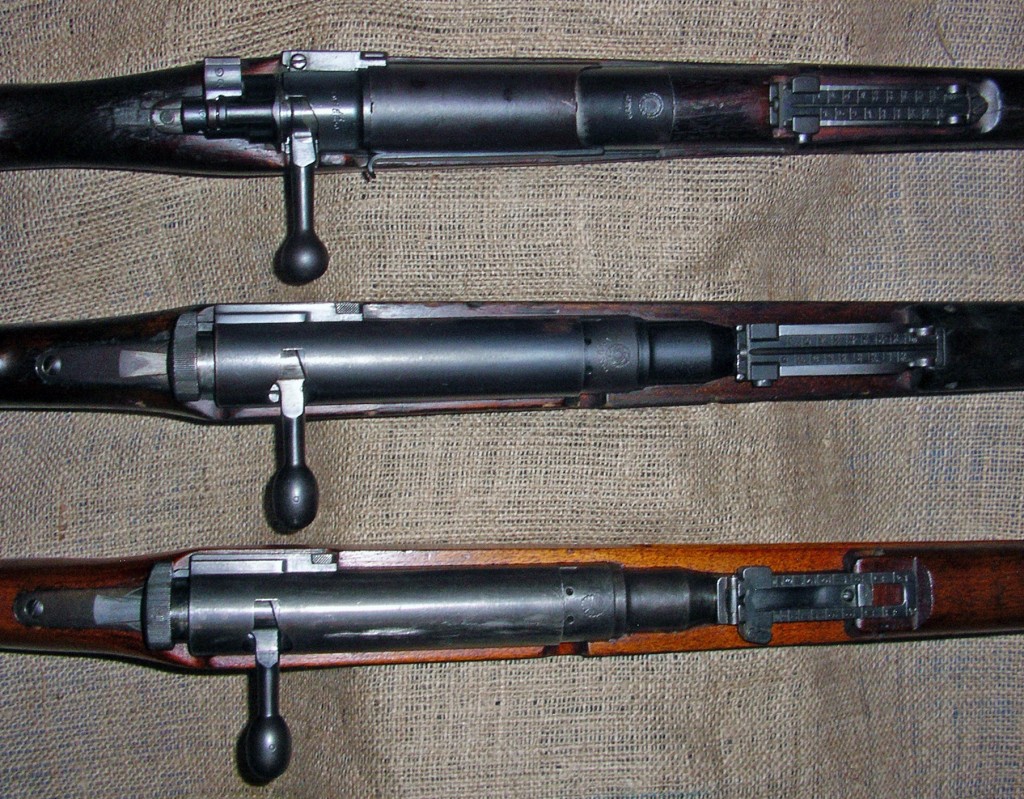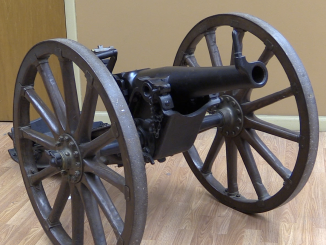When I put together the video and post a couple weeks ago on the Siamese/Thai Mauser, I figured I’d be clever and call it a Type 45/66, since it had been rechambered for the Type 66 cartridge. Well, I got an email from Teri the Nambu Lady politely informing me that I’d totally mangled the designation (my words, not hers). In fact, it was a Type 46 rifle (the Thai calendar doesn’t start at January 1st, so our year of 1903 was partly 2445 and partly 2446 by their calendar). And while the modernized spitzer cartridge was the Type 66, the converted Mauser rifles were not given that name. Instead, as it turns out, the Type 66 rifle was a totally different gun purchased by the Siamese government, and she hooked me up with some information on that rifle (thanks, Teri!).
Specifically, the Type 66 was basically a copy of the Type 38 Japanese Arisaka make under contract by the Tokyo arsenal for Siam. By happy chance, Teri has examples of all three rifles, and sent a couple photos showing them side by side:

When the Siamese military decided to update their small arms to the 8x52R spitzer cartridge, King Vajiravudh had succeeded King Chulalongkorn (his father), who had been in power when the Type 45 rifles were originally purchased. The new King had been educated in England, and actually wanted to replace the rifles all with .303 SMLEs (and he did buy 10,000 of them for some of his elite forces). His generals talked him out of that idea because it would require replacing all their machine guns as well to maintain a single cartridge. Instead, he was approached by a Japanese export firm that was marketing the Type 38 Arisaka rifle. These could be obtained in the new 8x52R cartridge quite a bit cheaper than Enfields would be, and the King decided to order 50,000 of them in 1923, under the designation Type 66 (the Thai year being 2466).

Interestingly, despite bearing a very close resemblance to the Type 38 Arisaka, it and the Type 66 have virtually zero interchangeable parts – even the screws in the Type 66 are cut to a different thread pitch. The stocks are shorter, the bands are held by machine screws instead of springs, the front sight base is integral to the barrel, and the rear sight is of the Mauser tangent type instead of the Japanese ladder style. The Type 66 was supplied with bayonets that followed the pattern of the Japanese Type 30 bayonet closely, but are again not interchangeable because the Type 66 has a slightly different muzzle diameter than the Type 38 Arisaka.
Production of the 50,000 rifle order ultimately took five years, with the final deliveries not taking place until 1928. The reason for this slow production isn’t known, although it could be the Siamese government wanting to pay in yearly installments, or possibly the result of damage to the Tokyo production facilities from the catastrophic Tokyo earthquake of 1923.
Type 66 rifles are very rare in the US today, as they were not surplussed by Thailand until the 1970s, and the 1968 GCA had curtailed the import of military arms. As a result, most of the Type 66s went to Europe and the Commonwealth nations instead of the US.



Thanks You
Very cool
Was the Arisaka’s breech modified to accept the rimmed Thai case?
or did the semi rimmed 6.5mm case headspace on the semi rim, allowing the Arisaka to headspace a rimmed roundwithout much tinkering?
Relative to the Mauser 98, the Thai mod 45 had the extractor claw reduced in height, the bolt face rim cut down and a lip of barrel brought back through the inner collar of the receiver, to provide a support for the front of the cartridge case rim to headspace against.
you must mean Siamese..?
Heh – yep.
fascinating. Informative!
Thx!
The Soamese cartridge, Was developed by the Danes and several milions, was made in Copenhagen, for the Siamese government.The basis, was the danish 8 mm model 89/08, with pointed bullit
Thanks for the additional information, Ian. Teri’s knowledge base and generosity are simply awesome.
There must have been at least a few Siamese Mausers that made it into the US before the ’68 GCA surplus ban. I had a stack of old (pre-68) American Rifleman magazines a friend of my dad’s gave me when I was a kid. (Great full-page Century Arms ads – amazing assortment of cheap surplus from the 1880s – 11mm Mauser bolts and Remington rolling blocks – to every bolt job and semi-auto used in WW2, at unbelievable prices.) But I remember seeing Siamese Mausers that had been re-barreled to .45-70 to take advantage of the rimmed-cartridge bolt and slapped in a sporter stock for less than a hundred bucks. Have no idea how many were sold or how well they worked.
For weird Thai stuff (not sure when the name change was) I recall reading an article debunking the American WW2 propaganda that the Arisaka was junk (if you read the books of the time the abuse heaped on the “.25 (actually 6.5) Jap” gave the impression that it was ballistically similar to a .25 ACP.) The author claimed – backed up by photos – that after the war the US re-barreled several thousand Arisakas to .30-06 and the post-occupation Thai army issued them to their troops.
Yep, there were a bunch of Arisakas rebarreled for .30-06 after the war. There was also copies made in 8mm Mauser in China, and brand new ones made in 7mm Mauser for Mexico prior to WWI.
The Mexican 7x57mm Arisaka rifles are flat out awesome. Rare, and hence, unbelievably expensive, but really neat.
How much about is this weapon worth? Insignia fully intact no pitting or anything in barrel wood and finish in amazing condition some indentations no cuts in wood or nicks
It’s worth about $1K to me if it’s as nice as you say.
I forgot to mention I recently acquired the top rifle on the picture with the 3 together I got it for $450
Me and my brother both have a type 46 but in different conditions, but one thing I took notice to was the markings, I looked the thai language to translate all the numbers. The thing I found out is, every part with symbols that were numbers had a different number plus most being in thai then some being english. Like the top of the reciver says 27830, but underneath it has a 187. Idk if the parts are mixed matched or they did that on purpose. Plus the rifle has a japanese manufactering stamp on the side of the reciver.
Also forgot to add is that the 27830 is in thai while the 187 is in english
Wondering about the 6.5 Arisakas are they available I like the Sweede too.
I have one of the up-graded 46s. It shoots the highly modified 8x56RS Mannlicher brass. I use a 150 grain bullet with a reduced load. It seem to be accurate at 100 yards. Accurate means 6″ dia., I think. I traded labor for the rifle back in the last century. Good price for a war keep sake.
I am a Vietnam veteran. I was stationed in Thailand back in 1966-67. I saw the Thai trainees use this rifle for guard training, etc.. The Thais told me that they sent solders to Europe and they froze to death. I believe that story because the Thais died of exposure while I was there, about 60 Degrees at night. I used it during a St. George sand storm. I didn’t need to use the dust cover!
Hey Ian,
I watched your video and I was wondering where you got your information for 400,000 of Type 45/46 rifles being produced. The research I’ve done suggest that there were only 40,000 made.
Very interesting comments related to the actual model # of these rifles. I have a type
66 rifle and a type 66 carbine in my collection that I purchased at various gun shows in the Cleveland.Ohio are in the 1970s. As commented, they are very rare, as I never see these weapons at the gun shows I go to (2024). I have some ammo for them too.
* In response to the purchase of .303 British Enfield rifles by the Siamese Military, I also have in my British portion of my collection a British Enfield Bayonet stamped with a Siamese Tiger on it.